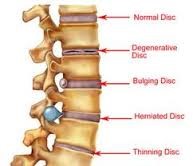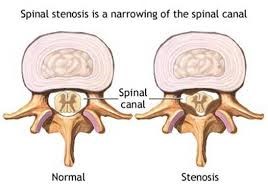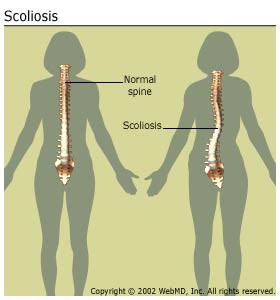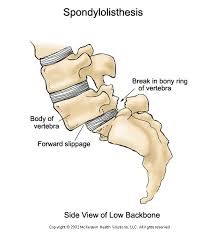-BACK
Display
Herniated or Bulging Disc of the Back/Lumbar Spine
A disc is a jelly-like, fluid filled sac that acts as a cushion between the bones of your back (vertebrae). Your discs change as you age, drying out and becoming more brittle. In addition, as the discs dry out with age, the change in height between the vertebrae decreases, causing changes in posture and function. In younger adults, the center of the disc (nucleus) is held in place by many rings of the disc (picture a cross section of a tree trunk). With minor or major injuries, poor posture and strain, these rings can rupture allowing a pressing outward of the disc nucleus. Finally, as the nucleus reaches the outer edges, the disc can begin to bulge, which in turn can rub and irritate nerve roots exiting your spine.

In more severe cases, the disc can become herniated, which further presses into the spaces where nerves are exiting. Symptoms can range from localized pain, to numbness/tingling to a specific part of the back, hips, legs, or feet. In more severe cases complete lack of sensation, muscle weakness, and paralysis of an area of the lower extremity can occur. Changes in posture, strength, and range of motion can all affect the positioning of the disc and how much bulging or herniation is occurring.
How physical therapy helps
The majority of bulging and herniated discs can be treated conservatively with physical therapy. By working with your medical history, symptoms, and testing, our physical therapists can determine what areas have been affected. A thorough plan is then created to relieve pressure on the disc by improving joint function, muscle strength, and posture. Our physical therapists will often use a McKenzie based treatment program to help centralize and abolish the symptoms. Modalities, such as traction, ultrasound, or electrical stimulation may be used to reduce pain, muscle spasms, or inflammation. Our physical therapists work with you to recover lost strength and range of motion. In addition, we then train you on the correct exercises to maintain good posture and reduce the risk of future episodes.
Herniated or Bulging Disc
Herniated or Bulging Disc of the Back/Lumbar Spine
A disc is a jelly-like, fluid filled sac that acts as a cushion between the bones of your back (vertebrae). Your discs change as you age, drying out and becoming more brittle. In addition, as the discs dry out with age, the change in height between the vertebrae decreases, causing changes in posture and function. In younger adults, the center of the disc (nucleus) is held in place by many rings of the disc (picture a cross section of a tree trunk). With minor or major injuries, poor posture and strain, these rings can rupture allowing a pressing outward of the disc nucleus. Finally, as the nucleus reaches the outer edges, the disc can begin to bulge, which in turn can rub and irritate nerve roots exiting your spine.

In more severe cases, the disc can become herniated, which further presses into the spaces where nerves are exiting. Symptoms can range from localized pain, to numbness/tingling to a specific part of the back, hips, legs, or feet. In more severe cases complete lack of sensation, muscle weakness, and paralysis of an area of the lower extremity can occur. Changes in posture, strength, and range of motion can all affect the positioning of the disc and how much bulging or herniation is occurring.
How physical therapy helps
The majority of bulging and herniated discs can be treated conservatively with physical therapy. By working with your medical history, symptoms, and testing, our physical therapists can determine what areas have been affected. A thorough plan is then created to relieve pressure on the disc by improving joint function, muscle strength, and posture. Our physical therapists will often use a McKenzie based treatment program to help centralize and abolish the symptoms. Modalities, such as traction, ultrasound, or electrical stimulation may be used to reduce pain, muscle spasms, or inflammation. Our physical therapists work with you to recover lost strength and range of motion. In addition, we then train you on the correct exercises to maintain good posture and reduce the risk of future episodes.
Low Back Pain
Low back pain is one of the most common conditions seen by physicians and physical therapists across the country. It is said that over 80% of people will suffer some sort of low back pain during their lifetime. Low back pain can occur for a variety of reasons, but typically all have one or more of the following factors:
· Poor motion and mobility
· Spinal, abdominal, or hip weakness
· Poor coordination of the spinal, abdominal, and pelvic muscles
While there are many items to mask low back pain, such as medication, it is important to address the true causes of low back pain. Most low back pain is caused by the 3 factors above. When your spinal joints and muscles don’t move properly, tremendous strain occurs in your low back. This causes irritation and inflammation, which builds up over time. Typically, low back pain sufferers will have more pain after sitting or lying down for prolonged periods, such as getting up from a chair or first thing in the morning after sleeping. With severe pain, reaching or bending down for objects can be limited.
If pain is felt more with prolonged standing or walking, this can be a result of significant hip or spinal weakness, again causing strain to the low back. With weakness in the spinal, abdominal, or hip muscles, the amount of force transferred to the back with everyday activities increases. With bending down, the knees are often not used properly, and the muscles of the spine have to do extra work. This sets up the person for injury with lifting or even something as simple as bending down to tie one’s shoes.
How physical therapy helps
Physical therapy is one of the best choices to treat low back pain. By addressing the three main issues, your normal back movement and strength can be restored. Our physical therapists focus on your posture, spinal mobility, strength, flexibility, and the way you move your body (body mechanics). As we observe and measure these indicators, we can detect weak areas and evaluate where your primary problem is coming from. A thorough plan is then determined to address your core issues and relieve your low back pain quickly. This allows you to have fast pain relief, improving your spinal range of motion and body strength. We also focus on prevention of future injuries and educate you on proper posture and body mechanics.
• Mid Back Pain
Mid-back/Thoracic Pain
Mid-back pain refers to pain in the “thoracic” spine. This is the area from the shoulders down to the mid-back area. Pain in this area can be for a variety of reasons, but typically occurs from poor posture or a forward slouched posture. With this posture, your back muscles stretch out, causing weakness. Pain can often feel like a burning or sometimes shooting pain to the mid-back area. At times, pain can even feel like it is radiating under the shoulder blade.
How physical therapy helps
Physical therapy is very important in treating mid-back pain. Our physical therapists work with you to discover spinal areas that may not be moving ideally. This limitation in movement can cause strain on the sections above and below that affected area. By improving spinal joint mobility, soothing sore muscles, and restoring posture, your mid- back pain can be relieved quite quickly. We then educate you on proper strengthening and postural techniques to maintain your gains in therapy.
Mid Back Pain
Mid-back/Thoracic Pain
Mid-back pain refers to pain in the “thoracic” spine. This is the area from the shoulders down to the mid-back area. Pain in this area can be for a variety of reasons, but typically occurs from poor posture or a forward slouched posture. With this posture, your back muscles stretch out, causing weakness. Pain can often feel like a burning or sometimes shooting pain to the mid-back area. At times, pain can even feel like it is radiating under the shoulder blade.
How physical therapy helps
Physical therapy is very important in treating mid-back pain. Our physical therapists work with you to discover spinal areas that may not be moving ideally. This limitation in movement can cause strain on the sections above and below that affected area. By improving spinal joint mobility, soothing sore muscles, and restoring posture, your mid- back pain can be relieved quite quickly. We then educate you on proper strengthening and postural techniques to maintain your gains in therapy.
Sciatica and Radiating Pain
Sciatica
Sciatica is the term used to describe radiating pain into the buttock that can travel down the back of the thigh. Often this pain is achy and spread out along these areas. Sciatica is a result of irritation to the sciatic nerve, which travels deep in the buttock and down the back of the leg. In about 20% of people, the sciatic nerve pierces through the piriformis muscle deep in the buttock instead of under it. This can make the sciatic nerve more susceptible to irritation and pressure from the piriformis muscle. The piriformis muscle helps guide hip movement, but can become very tight with prolonged sitting. This increased tightness causes pressure and irritation to the sciatic nerve, causing pain.
Radiating Pain
Radiating pain to the leg doesn’t necessarily mean you have sciatica, but it does tell you that something is wrong. Irritated muscles and tissue often can radiate pain. Spread-out, achy pain is often indicative of this type of problem. Sharp, stabbing pain with numbness or tingling is more often nerve irritation or compression occurring in the low back or leg. These types of sensations typically occur to specific parts of the leg.
How physical therapy helps
Physical therapy is one of the best treatments for sciatica and radiating pain into the leg. It first takes a thorough evaluation to determine where your problem is starting. Our physical therapists take time to examine the movement of your spine, hips, and legs. Range of motion, strength, joint mobility, and muscle condition are assessed by our physical therapists. After we determine the root cause of your problem, we put together a comprehensive plan to quickly relieve your pain, relieve your radiating symptoms, improve your range of motion, improve strength, and help you to prevent future episodes.
With specialized hands-on techniques, we work to improve your spinal and hip mobility, reducing pressure on your sciatic nerve. In addition, modalities such as heat, ice, electrical stimulation, and ultrasound may be used to reduce inflammation and resolve your pain quickly. We then perform stretching and strengthening exercises to restore your normal motion and strength. This results in lasting effects that will stop your pain from returning.
Spinal Arthritis and Spinal Stenosis
Spinal Arthritis
Spinal arthritis is a very common area for osteoarthritis and rheumatoid arthritis. The low back takes tremendous strain throughout our lifetime, supporting the body, moving, sitting, and repetitively bending. In addition to these contributing factors, arthritis can also be affected by genetics, age, previous injuries, diet, and exercise. With abnormal forces on the back, the cartilage on the joints at each level of the spine can rub down causing uneven wear, build up of bone, and eventually bone-on-bone rubbing. This can result in painful movement of the spinal joints and chronic, achy pain in the low back. Much like an arthritic knee, the spinal joints are helped through restoring natural movement, improving support from the spinal/abdominal muscles, and proper posture.
Spinal Stenosis
Spinal Stenosis is a condition that typically goes hand in hand with spinal arthritis. Spinal stenosis refers to a narrowing of the central spinal canal, or the canals where the nerves exit the spine to the lower legs (called foramen). These canals are made up of overlapping spinal bones (vertebrae) over another. With degeneration of the spinal joints, collapsing of the disc height or abnormal bone growth, the canals can narrow. This leads to rubbing and even pressure on the nerves, which can cause a multitude of symptoms.

How physical therapy helps
Physical therapy can have a very positive effect on patients with spinal arthritis and spinal stenosis. While our therapists cannot revert your arthritis degeneration, we can restore more natural movement to the spinal joints, improve flexibility to increase joint fluid circulation, improve spinal/abdominal muscle strength, and educate you on correct posture and prevention techniques. The result is that you can do more, with less pain. Often, patients report significant reduction in pain and improvement in daily activities from just a few short weeks of physical therapy.
Osteoporosis
Osteoporosis is a very common condition in women over the age of 40, but men do suffer from this condition too. Osteoporosis is a thinning of the bones due to the change in calcium depositing and uptake. As we age, this cycle tends to take out more calcium than is put back into our bones. Common areas for osteoporosis are in the spine and hips. Osteoporosis makes people more susceptible to compression fractures from ordinary activities. The good news is quite a bit can be done to address osteoporosis and even improve bone strength. This comes from strengthening exercises, medication, a good walking program, and proper nutrition.
How physical therapy helps
Since strengthening is a critical component of osteoporosis management, physical therapists are experts in preparing a coordinated, easy-to-do exercise program to target specific osteoporotic areas. Often, people with osteoporosis will also have limited spinal and hip movement, which increases the stresses on bones. Our physical therapists are experts in treating these limitations and restoring your body to a more optimum state. We work in conjunction with your doctor to program a specific treatment plan to ensure you a road to stronger bones and injury prevention.
Scoliosis
Scoliosis is a condition that affects the normal shape of the spine, altering a person’s overall trunk alignment and posture. Scoliosis causes the spine to move to the side and turn. This condition can occur at any time during the lifespan, but is more commonly detected during adolescence. Scoliosis affects 2% to 3% of the general population, and is more common in females than males. Scoliosis ranges from mild to severe cases, requiring a variety of treatments. The more severe cases may require surgery. Scoliosis is best managed with a team approach that includes the family, orthopedic physician or surgeon, orthotist, and physical therapist.

How physical therapy helps
The variety of treatment options for scoliosis includes physical therapy, bracing, and surgery. Determining the best course of treatment is based on the type and severity of the scoliosis, the patient’s age, and the guidelines established by the Scoliosis Research Society.
Physical therapists can provide care during any of the phases of scoliosis treatment, including bracing or post-surgery. Our physical therapists will evaluate and assess the posture and movement patterns of the whole body, noting any limitations caused by changes in the spine, and address other symptoms, such as pain and muscle imbalances. They will work with you or your child to develop an individualized plan tailored to the type and severity of the scoliosis, as well as patient goals. Your physician will continue to closely monitor progress throughout the course of rehabilitation.
display
Your content goes here. Edit or remove this text inline or in the module Content settings. You can also style every aspect of this content in the module Design settings and even apply custom CSS to this text in the module Advanced settings.
Spondylolisthesis
Spondylolisthesis is a condition where one spinal bone (vertebrae) is not in alignment with the other. Typically, a slippage forward is found in the very low back at the 4th or 5th lumbar (low back) vertebrae. This is due to a stretching out of the ligaments that hold the bones together or possibly a fracture. With poor posture and weakened abdominals as well as spinal muscles, the increase in the angle of the spine becomes too much over time and misalignment of the bones occurs.
 Symptoms can be mild such as general fatigue to the low back, achy pain, or severe symptoms if there is compression on the nerves exiting the spine or spinal cord. There are varying degrees of severity. Most fall into a mild to moderate category that can be stabilized with improved posture and muscle strengthening. In severe cases, surgery may be necessary to fuse the area and bring stability back.
Symptoms can be mild such as general fatigue to the low back, achy pain, or severe symptoms if there is compression on the nerves exiting the spine or spinal cord. There are varying degrees of severity. Most fall into a mild to moderate category that can be stabilized with improved posture and muscle strengthening. In severe cases, surgery may be necessary to fuse the area and bring stability back.
How physical therapy helps
Physical therapy helps to bring stability and support to the low back, allowing the muscles to create more support for the overstretched ligaments. Our physical therapists work with you to create a program that improves mobility in other spinal areas that may be inflexible, strengthen key muscles to stabilize the spine, and educate you on the proper techniques to maintain spinal stability.
Other areas may need to be addressed such as hip weakness, poor balance, or radiating symptoms to the legs as well. Physical therapy can help treat the root source of these symptoms and get you back to feeling great quickly. In the event that surgery is required, we will be with you every step of the way to ensure a thorough recovery.
Degenerative Diseases
Degenerative diseases of the spine fall under the categories of Degenerative Disc Disease (DDD) or Degenerative Joint Disease (DJD). In the spine, this is typically due to age and genetics. The wearing down of the joints or discs causes loss in normal height of the bony segments in the back. This can cause excessive joint pressure, bone-on-bone rubbing, and increased inflammation. Typically with DDD or DJD comes stiffening of the spinal joints and weakening of key spinal muscles.
How physical therapy helps
While the degenerative process cannot be reversed, there is a lot that can be done to improve mobility, reduce pain, improve strength, and improve function. Physical therapy is the ideal, non-invasive treatment that helps to improve spinal flexibility, core muscle strength, reduce pain, and improve posture. All of these contribute to less pain and a return to normal or modified activities.
Compression Fractures
Compression fractures in the low back typically occur in older individuals and those suffering from osteoporosis. However, with severe trauma, such as an accident, the force can cause a compression fracture in the bones of the spine (vertebrae). There are many minimally invasive surgical procedures today that can stabilize the broken area, such as kyphoplasty.
The goal with managing compression fractures is to stabilize pieces of bone from moving around and allow time for the bone to heal. Dealing with a compression fracture can be quite painful. Difficulty with getting up/down from a bed or chair and even difficulty walking are often experienced.
How physical therapy helps
Our physical therapists work with your physician’s protocol for compression fractures. Based on your individual difficulties, we work with you to gently rehabilitate your spinal movement and strength. Our physical therapists have years of training in helping patients with back injuries and will work with you to relieve your pain, improve your mobility, gain strength, and get you back to normal activities as soon as possible.
Sprain / Strain
It can be quite easy to sprain or strain your back. A sprain refers to an overstretching injury of your ligaments in your spine, whereas a strain refers to an overstretching injury to your muscles. There are many small muscles in the spine, which guide the intricate movements of each bone and multi-level joints. This delicate ballet of movement can get into trouble when heavy lifting is involved.
The majority of people sprain or strain their back when they combine lifting with twisting. The best way to avoid an injury to the low back is to use your legs when lifting, bending at the knees, and keeping your back fairly straight. If you have to turn while lifting, move your feet, otherwise the strain of lifting while twisting can cause injury.
Tearing of the tissues occurs during a sprain/strain. While this is often not a full complete tear, the resulting damage can cause significant swelling and pain to occur deep in the back.
How physical therapy helps
Physical therapy is very important in your recovery from a back sprain/strain. The sooner we can see you, the better. After the injury, it is important for you to receive therapy to reduce the inflammation process as quickly as possible. Often, the root cause of the problem is limited motion in the hips or pelvis and even mid-back, which causes abnormal forces in the low back.
Our physical therapists work with you to loosen any restricted areas, improve movement, quickly reduce your pain, and strengthen your core muscles to prevent injury. It is vital that you complete a full course of therapy to ensure that you don’t re-injure your back again. Studies have shown that people who do not properly retrain their core muscles after a sprain/strain injury are more likely to re-injure their back again.
Post-surgery Rehab
There are many surgical procedures for the low back including discectomies, laminectomies, and even spinal fusion surgeries. The goal of most of these surgeries is to remove any broken bone, tissues, or discs that may be pressing on exiting nerves from the spine. Furthermore, bringing stability to the spinal area is critical. It is important that you discuss with your physician conservative treatments first, such as physical therapy before surgery is absolutely necessary.
How physical therapy helps
Physical therapy plays a critical role in the recovery after low back surgeries. We work closely with your physician to ensure that we follow the surgical protocols in your recovery. Typically, the first phase is to help with pain relief and education in proper movement to protect your surgery site while healing occurs. As your physician clears you for more activities, gentle hands-on therapy and very gentle exercises of the legs, hips, abdominals, and supporting muscles begin. Generally, range of motion and activation of stabilizing muscles has begun.
As you heal and your surgery protocol allows, gentle strengthening exercises begin along with specific stabilization exercises to rehabilitate your core muscles that support your spine. Our physical therapists also assist with walking, balance, and spinal coordination. The goal is to reduce your back pain quickly, protect your spine during recovery, and properly rehabilitate your spine to allow you to return to normal activities.
